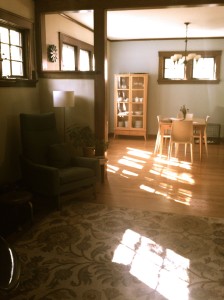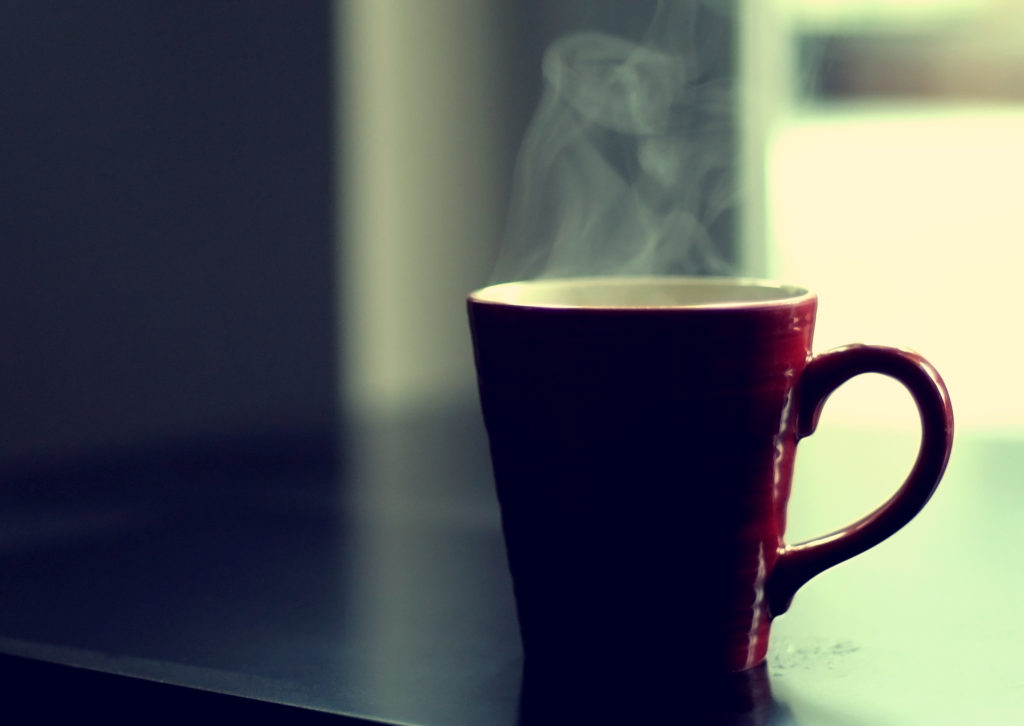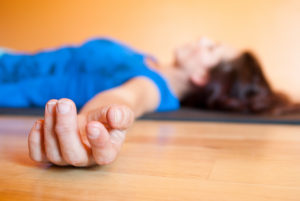It’s only 1 pm and already the day has been long and full. I can feel myself bracing against it, a response that is, at once, both offensive and defensive—meant to conquer and to protect.
My instinct is to keep pushing against and through the day, but instead I take a cue from my dog. Locating the patch of sun on the living room rug, I lie down flat on my back, in what is known in yoga as shavasana, the corpse pose.
Not only is the term shavasana somewhat new to me, as I’ve just recently committed myself to a yoga practice after a few years of only taking a class here and there, but the entire concept is foreign. Being a good corpse can be tricky for the living—especially, it seems, for me. The idea of being awake but not doing anything, other than holding an awareness of the rise and fall of my abdomen with each breath, does not come naturally.
But I try, nonetheless. The trick is to try without trying too hard, which has a way of defeating the purpose. All I can say is thank goodness for eye pillows. Without one, my eyes would never close, or even cease their darting behind my closed lids. If there was such a thing as a body-sized eye pillow, I would gladly let its gentle weight hold me down.
 Instead, I wiggle a bit, to introduce my body to the rug—to the idea that, for now, it isn’t responsible for holding me upright.
Instead, I wiggle a bit, to introduce my body to the rug—to the idea that, for now, it isn’t responsible for holding me upright.
Next, I release my tongue from the roof of my mouth, where it always seems poised, ready for the next word.
I let my hands grow heavy and limp, imagining them putting roots into the floor rather than tapping over the keyboard, matching a pile of clean socks, or comforting a child.
I notice that my shoulders, always curving into the tension of my work and life, are the last part of me to give in to this crazy thing I’m doing here in the middle of my work day: lying in a patch of sun on the rug, like my dog. I mentally coax each shoulder down toward the rug below, then down and back even further. They have so far to go, so much to relearn.
Finally, I am aware only (mostly) of the sun warming my chest as it rises and falls.
* * * * *
I am a doer. That sounds like a brag—like I’m touting a true American character asset. In many ways, it is an asset. Being a doer is certainly not something you’d hide in a job interview.
But as one who is always compelled to do the doing, I’m not so sure.
“I’m sensing a very deep-seeded, emotional holding pattern,” my massage therapist said last week, after several sessions of intense work meant to release the muscle mass reaching across my shoulders and up my neck. The massage work, he told me, has accomplished what it should in terms of releasing the individual muscles, but something in my being is refusing to let go.
I left his office feeling discouraged that my massage therapist couldn’t just do something to make me better, but also recognizing the irony of that. I wanted him to do so that I could keep doing—an unsustainable cycle of short-term fixes.
* * * * *
Doing is satisfying. It makes me feel useful and necessary.
Doing enables me, at the end of the day, to look back at the previous 12-or-so hours and quantify their worth. It makes me feel like I’ve somehow earned that glass of wine with dinner, a TV show before bed, and a good night’s sleep. I need it, after all—tomorrow brings another day of doing.
There is, of course, a cultural construct built around the idea of being busy and productive, but I can mostly let go of that. Busyness isn’t something I feel proud of, a “humble brag” I would share on Facebook. For me, it’s the energy I get from doing that I’m addicted to. I love generating ideas, collaborating with others, and making good things happen. I love seeing where there are holes in the world around me and then figuring out how to fill them, so that places and communities and lives are better.
Being engaged through doing also gives me a satisfying sense ownership, whether in my writing business, my church, or my daughters’ school. And yes, I’m sure there’s a bit of a control-freak factor mixed in there, and probably some fear of failure (who am I kidding?). There’s a good chance that’s part of what my massage therapist was sensing in my body.
Either way, it’s no joke. I need to do something about it. (Ha! There it is again. Do. I can’t help myself.) Although in truth, I’m beginning to realize there’s not much I can do about this, other than learn to be. Earlier this year, as many bloggers I know were choosing their #oneword for 2015, I began to see the name of this very blog, You Are Here, in a new way: not just as a way to think about place, but as a way to think about being—being present where I am.
Maybe my word for 2015 should simply be “Here.” I am here. In this place. In this moment. In this body. I am here whether I’m doing something or, as our culture likes to call it, doing “nothing.”
* * * * *
In the case of lying corpse-like on my living room floor in the middle of the work day, the “doer me” would love to say I’m doing shavasana. But I’m learning to shift how I think. For now, I’m not doing, I’m simply being.
Gradually, I feel the sun creeping onto my right shoulder, rewarding it for accomplishing its most difficult task: letting go. Turning my face toward the sun, I let the eye pillow slide to the floor, keeping my eyes closed so they can begin adjusting to the light through my lids.
When I finally open my eyes, they take in the slant of sun through the living room window—the sun I have felt and can now see. My eyes observe how the dust in the air and the silver thread of a spider’s web connected to the window’s sill give the sun more dimension. I take one more deep breath before pushing myself up off the rug, and I think, No, I don’t need to dust. Maybe eventually, but for now I will just notice.



